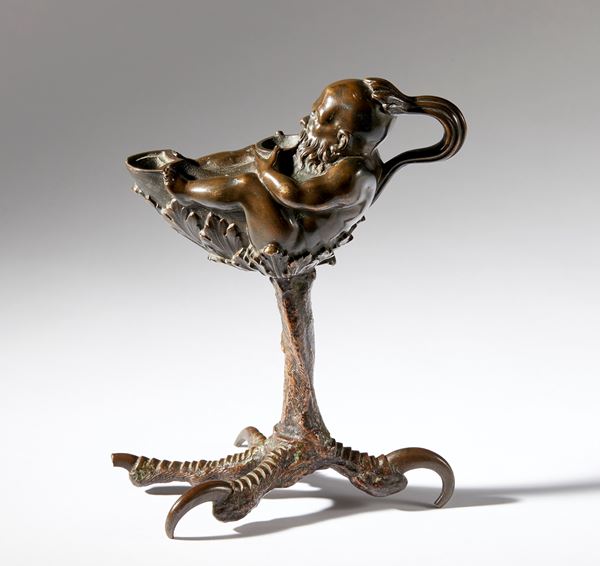10
Dwarf-shaped lamp on a bird of prey's leg, Padua 16th-17th century.
Bronze with reddish patina on black traces. 21x16x13 cm
Broken nail.
The lamp examined here depicts a dwarf lying down and drinking from a cup placed on his sternum. This grotesque figure is supported by a bird of prey's paw anchored to his back. The connection between the claw and the back is resolved with a circle of acanthus leaves. The dwarf is depicted naked with a long beard and a large bald head.
Bibl. Wilhelm Bode, The Italian Bronze Statues of the Renaissance, Bruno Cassirer Publisher, Berlin. Leo Planiscig, Small Italian Bronzes of the Renaissance, Fratelli Treves Editori, Milan, MCMXXX.
Broken nail.
The lamp examined here depicts a dwarf lying down and drinking from a cup placed on his sternum. This grotesque figure is supported by a bird of prey's paw anchored to his back. The connection between the claw and the back is resolved with a circle of acanthus leaves. The dwarf is depicted naked with a long beard and a large bald head.
This curious bronze object is a table lamp and, consequently, the hollow body of the dwarf constitutes the bulb containing the oil while the cup from which the character drinks serves as a hole to pour the liquid. Finally, the wick was placed in the cavity between the dwarf's feet, immersed in the burning oil and then lit.
Once the wick is lit, we can only guess what mysterious luminous effect this "extraordinary" object of common use created. We can only imagine whether it was placed on the desk of an Aristotelian professor at the University of Padua, or whether it belonged to a cultured humanist who saw in this bronze the materialization of classical antiquity captured in its most grotesque aspect, or to a Renaissance prince.
Aristotelianism did not disdain the observation of nature and this is the reason for the proliferation in the Padua area of many small bronzes in the shape of animals taken directly from life: crab-shaped inkwells, lamps as in our case supported by the legs of a bird of prey or compositions of coiled snakes fighting.
The apparent futility of certain bronzes is motivated from a philosophical point of view as an observation of nature.
Returning to our bronze statuette, we trace its models in the Roman anthropomorphic lamps that archaeological excavations brought to light in those very years: grotesque heads that spit fire, dwarves riding horses' heads and other infinite variations on the theme.
Our crouching dwarf re-proposes that type of archaeological lamp, reinventing the subject, and is placed in balance on a clawed paw that serves as a grip and support. In this regard, it is worth remembering the production, in the Renaissance period, of other similar bronze lamps where the paw supports dragons that spit flames, satyr heads or acrobats with raised legs that emit fire from the sphincters.
The lamp examined here is documented by the great German historian Wilhelm von Bode (1845 - 1929), one of the first scholars to catalogue Renaissance bronzes while serving as director of the civic museum in Berlin, now called the "Bode Museum" after himself. In his fundamental text on Renaissance bronzes, this lamp is attributed to Andrea Briosco, known as Riccio, as was the custom at the beginning of these studies, and we stick to this (Rosenheim collection). Modern art criticism has traced many bronzes, previously attributed to Riccio, back to the workshop of Severo Calzetta da Ravenna (Ravenna, circa 1465 - 1543), another great Renaissance bronze artist working in Padua, whose production has been taking shape in the last few decades.
Even the great scholar Leo Planiscig, another leader of these studies, cites the same lamp and also publishes the image, with the same attribution.
Bibl. Wilhelm Bode, The Italian Bronze Statues of the Renaissance, Bruno Cassirer Publisher, Berlin. Leo Planiscig, Small Italian Bronzes of the Renaissance, Fratelli Treves Editori, Milan, MCMXXX.
Live auction 329
Placquettes, Medals, Sculptures and Ceramics from the 14th to the 19th century
Palazzo Caetani Lovatelli, wed 5 March 2025
SINGLE SESSION 05/03/2025 Hours 15:00
New lots currently at auction


















